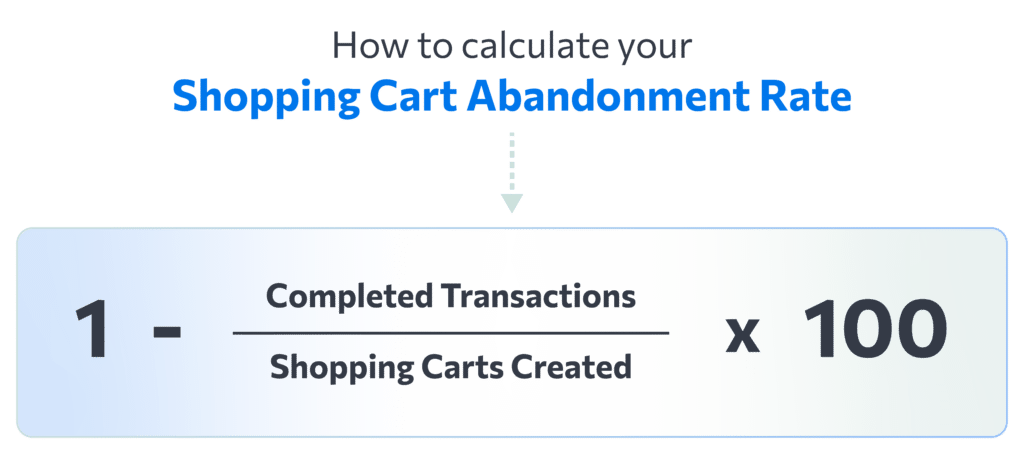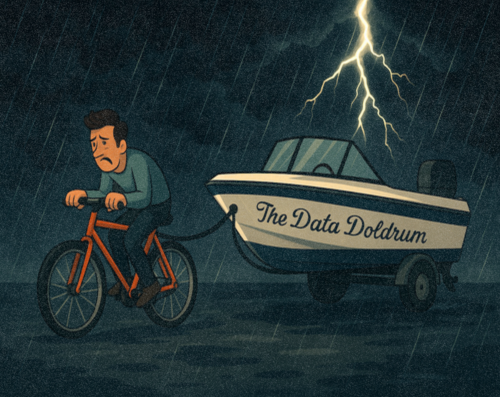Shopping cart abandonment: The moment when a customer is “thisclose” to completing a transaction, but something prevents them from following through…and you’re left trying to understand why.
There are many reasons that a potential customer may choose to add items to a shopping cart on a website and then decide to not purchase—some that are in your control, and some that are not. As age-old wisdom guides us: focus on what you can improve, correct, or change—and ignore the rest. This also applies to implementing strategies to reduce your abandoned shopping carts and increase your completed sales.
You can’t prevent potential buyers from window shopping or getting distracted, but you can take measures to stop chasing away the customers who actually want to purchase an item, but get deterred in the process of doing so. This article is your guide to 10 common reasons that customers abandon their shopping carts, along with practical ideas for resolving them.
What is shopping cart abandonment?
Shopping cart abandonment refers to any scenario where potential customers begin an online transaction, but they leave the website without completing the transaction. This includes adding items to a shopping cart, as well as beginning the process to sign up for a subscription service.
Although troublesome for businesses, shopping cart abandonment is quite common and continues to rise. While mobile devices provide a convenient and accessible means for consumers to shop, making it easy to “add items to cart,” consumers are less enthusiastic when it comes to completing the purchase, or signing up for a subscription service. This is for a variety of reasons, which we’ll cover below.
How to track shopping cart abandonment
Tracking the volume of your abandoned shopping carts should not be done in a vacuum. While it is a very important metric, it should be tracked along with other KPIs such as average order volume, gross profit margin, website speed, and website conversion rate.
To track your shopping cart abandonment rate, you need access to two key metrics:
- Number of shopping carts created (in a given time period)
- Number of transactions completed (in a given time period)
Product analytics platforms such as Kubit can provide you these metrics, so you can get started tracking your shopping cart abandonment rate.
How to calculate your shopping cart abandonment rate
If you want to reduce the number of instances that people abandon their shopping cart on your site, you need to start by measuring how often it’s happening today. To calculate your shopping cart abandonment rate, identify how many completed purchases your website had in a given time period, such as a month, a quarter, or a year. Next, identify how many carts were created in that time period. Divide the number of completed purchases by number of carts created. Subtract that number from 1 and multiply by 100. This is your shopping cart abandonment rate.

For example:
Completed purchases: 90
Carts created: 400
Shopping cart abandonment rate: 1 – (90/400) x 100 = 77.5%
What is the average shopping cart abandonment rate?
According to Baymard Institute, the average documented online shopping cart abandonment rate in 2024 is 70%. That means that only 3 out of every 10 customers that add items to their shopping cart actually complete the purchase.
It’s important to note, however that shopping cart abandonment rates vary on different devices. As people behave differently when shopping on mobile than they do on desktop, device-specific cart abandonment rates reflect that. In December 2023, the average value of e-commerce purchases made through desktops was approximately $159, while comparable purchases completed on mobile and tablets were closer to $100. However, desktop shopping cart abandonment rates (73%) are higher than on tablets (80%) and mobile (85%).
Clearly, it is not possible to eliminate shopping cart abandonment. The focus, rather, should be to benchmark your business’s abandonment rate and start taking steps to improve it.
How does shopping cart abandonment impact e-commerce?
However common shopping cart abandonment may be, the fact remains: abandoned shopping carts are lost sales, and thus lost revenue. Particularly if your business is making a significant investment in getting shoppers to your website via ads, paid search, social media tactics, and other marketing campaigns, losing those potential customers at the last moment can be detrimental to your goals.
A high shopping cart abandonment rate can also be a sign of bigger issues within your sales process, user experience, or brand perception. It could indicate that your customers’ expectations of the purchase process are not being met, or that there is a problem with your website that’s deterring them. Identifying which points of friction in the buyer journey are contributing to the abandonment is key to driving improvements that lead to greater retention.
Let’s explore some of the common reasons that customers abandon their shopping carts, and what you can do to resolve them.
10 reasons for shopping cart abandonment
- High or unexpected costs and fees
When customers view items in their carts and see the total amount due inclusive of all taxes and fees, it can make the customer think twice. On lower-value purchases, the cost of shipping fees and service charges combined can sometimes outweigh the value of the purchase. Flat-rate shipping fees can also deter some shoppers who don’t perceive the cost of it to be equal with the actual price of shipping their particular order. Some shoppers may add items to their carts for the sole purpose of finding out how much their order will really cost, if it is not already evident. If the cost is not what they expected, they will abandon the cart.
Fix it:
- Make pricing more transparent from product pages, so buyers know the estimated shipping cost before putting an item in the cart.
- Include the cost of shipping in the cost of your products, so you can offer the buyer “free shipping.”
- Offer various delivery options and pricing, including less expensive ground shipping for buyers who would rather wait for their item and spend less on shipping.
- Inconsistent checkout experience
Consumers value a delightful user and brand experience, from the beginning to the end of the buyer journey and on every device. When your customers initiate a checkout process, and they are taken to a different page on your website that does not deliver the same brand look and feel that the rest of your website does, they get uncomfortable. The same is true for inconsistent experiences between desktop and mobile devices. That discomfort can quickly lead to shopping cart abandonment.
Fix it:
- Test your checkout process on different browsers and devices to assess where it is inconsistent, and take action to improve it.
- Have your brand and design team review your checkout process to ensure that the copy, tone of voice, colors, and logos are of the same quality as the rest of your website.
- Display security badges prominently throughout the checkout process and include customer testimonials or other “trust” elements to reassure your customers.
- Preferred payment unavailable
Preferred payment methods and their availability vary across regions and cultures, so providing your customers with their payment method of choice can make the difference between them clicking “complete purchase” or not. Whether your target audience prefers a transfer directly from their bank account, entering a credit card number (Visa, Credit Card, American Express), or using popular payment methods such as PayPal, Stripe, or Apple Pay, your buyers want options. If a customer doesn’t see their payment method of choice offered in the checkout process, they may be forced to make their purchase elsewhere.
Fix it:
- Get to know your target audience better. Research the preferred payment methods by demographics, regions, or specific cohorts.
- Offer different payment methods to specific markets if applicable.
- If adding additional payment methods is cost-prohibitive, prioritize major payment methods first and expand as you are able.
- Forced account creation
Something that appears as simple as creating an account to complete a purchase can actually be the tipping point at which the customer abandons. When customers are required to create an account to make a purchase from your website, it can cause them a number of concerns. Making a first-time purchase from your website is already a commitment for a new customer, but creating an account with you increases that commitment. They may not be ready to share their email address with you, receive marketing emails, or consent to sharing their personal information.
Fix it:
- Offer a guest checkout option, where customers can decide whether or not they want to create an account.
- Use the purchase confirmation page to offer customers the option to provide their email address for updates or special offers.
- Monitor conversion and cart abandonment for the two experiences to determine if it’s helping or hurting your abandonment rate.
- Payment security concerns
As mentioned above, payment pages that are inconsistent in your brand look and feel can spark concerns in your customers about authenticity and security. With fraud and identity theft continually on the rise, costing U.S. consumers alone an all-time annual high of $10.3 billion in 2023, you can understand their need for vigilance. Customer are looking for signs that they can trust your checkout process; otherwise, they may not want to risk it.
Fix it:
- Ensure that your website is SSL-secured, PCI compliant, and verified by trusted third-party security companies—and display trust seals throughout the checkout process.
- Offer your customers payment options that are familiar and trusted for their market.
- Use a fraud management system to detect and prevent fraud on your ecommerce store.
- Complex checkout process
Slow webpage load speed, multi-page checkout process, crashes, glitches…all of these less-than-ideal elements of your customer experience can send buyers elsewhere to make their purchase. Similarly, businesses that prioritize data collection over user experience in the checkout process can chase their customers away. Confusion of any kind in the checkout process should be avoided at all costs.
Fix it:
- Reduce the number of web pages that are needed for a customer to complete a purchase; stick by the rule of thumb that “less is more.”
- Reduce the number of assets that are required to load for each step of the checkout process; this will improve page loading speed and improve the customer experience.
- Simplify the checkout process to make it shorter and more straightforward, removing any unnecessary fields or steps.
- False declines
False declines happen when a legitimate transaction is rejected or declined by a bank or payment processor. This can happen when fraud management systems and algorithms detect seemingly fraudulent activity, such as unusual spending patterns, technical errors, incorrect information, or outdated authorization techniques. While customers can take actions to reduce false declines, the bulk of the work to prevent them rests on the business.
Fix it:
- Balance your fraud prevention controls with your customer experience and select fraud prevention systems that use machine learning and AI to adeptly distinguish between genuine and fraudulent transactions, reducing false declines.
- Implement multi-factor authentication, requiring additional verification for transactions that are flagged as suspicious, rather than declining the transaction outright.
- Analyze your transaction data with a customer analytics platform to identify patterns and trends that can help you understand which transactions are likely to be false declines.
- No customer support
When buyers have questions during the checkout process—about shipping, fees, returns, etc.—they expect quick answers. If they can’t find that information easily, they begin to lack confidence in your business and potentially take theirs elsewhere. Just like customers need options for payment methods, they also need options for getting their questions answered, such as through chat, online FAQs, or other support resources.
Fix it:
- Offer live chat support on all of your checkout web pages so that customers can get answers to their questions without having to leave the checkout page.
- Provide a list of frequently asked questions (FAQs), help articles, or tutorials in a convenient location on your website, so that most of your customers’ questions can be answered via self-service.
- Solicit feedback from your customers who have completed a purchase, asking them how you can improve your customer service and their customer experience.
- Return policies
Return and exchange policies that are either unclear, hard to find, or not customer-friendly, can greatly reduce the willingness of a customer to take a chance on a purchase from your site. Some businesses bury their return policies deep within their site, making them hard to find. Or, they use hard-to-understand language that makes it hard for the customer to confidently understand the policy. Neither of these practices inspires confidence or trust in your customer that they will be treated fairly in the event that they should need to return their purchase.
Fix it:
- Present a summary of your return and exchange policies clearly on your website during the checkout process, so your customer doesn’t have to search for it, and so that expectations are set from the beginning.
- Highlight key parts of the return policy that the customer should be made aware of, such as the requirement to pay for return shipping or a 30-day return window.
- If there are finer points to be shared about the return policy, provide a clear link to the location where the customer can continue reading, if desired.
- Just browsing
Some potential customers who are browsing various websites and conducting product research will put an item in their cart before they are ready to make a purchase. They may be adding a similar item to their cart on various websites, using this tactic as a way to compare features, pricing, and delivery options. These customers will choose to follow through with the purchase on the website that offers them the best price or shipping, and abandon all other carts.
Fix it:
- While browsing is an unavoidable stage of the buying experience, you can make the process more informative for the buyer by providing detailed information about shipping and fees on your product page, so they don’t have to add the product to a cart to find out more.
- Research which items of yours are being abandoned in the cart most and offer more competitive pricing on them so your potential customers will be more likely to choose your product when they are ready to buy.
- Use abandoned cart recovery tactics to encourage your abandoned customers to come back and complete the purchase.
Shopping cart abandonment frequently asked questions
What is checkout abandonment?
Checkout abandonment refers to potential customers who begin the checkout process but don’t complete the purchase. These guests have already added items to their cart and taken at least a first step toward “completing purchase.” But then they abandon the checkout process before fully completing it.
How is checkout abandonment different from shopping cart abandonment?
Shopping cart abandonment and checkout abandonment are similar metrics, but they take place at different points in the buyer’s journey.
- Shopping cart abandonment refers to any scenario where potential customers begin an online transaction, such as adding items to their shopping cart, but they leave the website without completing the transaction.
- Checkout abandonment refers to customers who have begun the checkout process but fail to complete the purchase.
What is abandoned cart recovery?
Abandoned cart recovery is a marketing tactic that aims to reduce cart abandonment by re-engaging with potential customers who added items to their cart but did not follow through with the purchase. This can be done via text message, personalized email messages, and incentives for prompt checkout. There are a variety of strategies for encouraging abandoned cart recovery, but the key is to understand what’s driving customers to leave their carts in the first place and then take action to fix it.
How can I monitor these improvements to see if it’s working?
Kubit’s funnel and path features allow product managers to assess if their conversion and abandon rates are improving. When you’ve implemented a fix such as “allowing guest check out” and you want to measure the impact you would build a funnel with this conversion flow and segment it by the users who leveraged the improved experience vs. those who did not. You’re also able to visualize the paths of these users especially if you’ve simplified the checkout process and want to see if it’s reducing the time to conversion.








